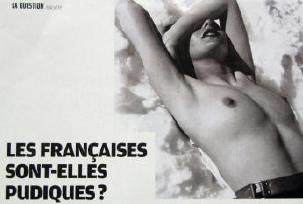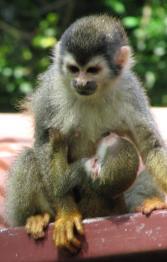
But did you ever stop to think, why is it that women have two breasts? My father once had a cookie, about a foot long from top to bottom, depicting a topless Scandinavian goddess with three breasts, in a horizontal line across her chest (the cookie was not for eating - it had in fact been varnished for preservation). This is not biologically possible, though. First of all, most animals are symmetrical around a centerline, so we have even numbers of things like eyes, arms, legs, and nipples. We only have one nose and one mouth, which are centered, but they are themselves symmetrical. Thus three breasts would be rather unlikely. Whatever the number, it ought to be even. In fact, mammals always have their nipples on two lines, called the "mammalian nipple lines", that run down the sides of the chest symmetrically on each side of the centerline. It's not infrequent for people, both men and women, to have a third nipple, but they are generally tiny, and are often taken for moles. They're called "supernumerary nipples", and they always fall directly below one of the normal nipples, on one of the mammalian nipple lines. But apart from such embryological accidents, the usual number of nipples in humans is two. More generally, the number of teats is usually constant within any given mammalian species. Cats and dogs have eight, for instance. There is a general rule, called the "one-half rule", that is true for the majority of mammals: the number of teats is approximately equal to the maximum litter size, which is generally equal to about twice the average litter size. This certainly holds true for humans: the average litter size is one, and the maximum litter size is two (twins). Absent fertility drugs, triplets are so rare as to be statistically insignificant. And that's why women have two breasts: because they generally have their children one at a time.
Human females, however, have prominent breasts even when they are not lactating, due to fat deposits around the actual mammary glands. That's what I'm asking about when I ask, "Why do women have breasts at all?", because prominent breasts seem to have no physiological use. Desmond Morris, in The Naked Ape, proposed that they evolved for the purpose of sexual attraction. It works for me. But not everyone agrees. I asked my daughter Elissa about it, because she has a Ph.D. in Biological Anthropology, and knows a lot about this subject. She replied, "There are several camps on this. Many do believe that breasts are the result of sexual selection. However, others believe that breasts are actually an honest signal of reproductive potential. Others think that breasts mimic honest signals. A recent theory suggests that breasts evolved in response to the shape of the baby's face (and increasing brain size)." Note 1 And there you have it.   Note 1: Elissa sent some references she had lying around: Bentley, G., (2001). Breasts shaped by evolution for babies, not men. New Scientist, April 11, 2001. Cant, J. G. H., (1981). Hypothesis for the evolution of human breasts and buttocks. The American Naturalist 117(2): 199-204. Low, B. S., Alexander, R. D., Noonan, K. M. (1987). Human hips, breasts and buttocks: Is fat deceptive? Ethology and Sociobiology 8(4): 249-257. [return to text]  |

 Actually, there's a question that's even more interesting, and controversial: Why do women have breasts at all? We're mammals, of course, but in most mammals, the nipples are flat to the chest in females as well as males, unless the female is nursing and the breasts are engorged with milk. Even then, they are often not very large. The picture at the right, which I took in Costa Rica, shows a squirrel monkey baby nursing while hanging on to its mother. We watched the babies cling like that while the mother took long flying leaps from branch to branch.
Actually, there's a question that's even more interesting, and controversial: Why do women have breasts at all? We're mammals, of course, but in most mammals, the nipples are flat to the chest in females as well as males, unless the female is nursing and the breasts are engorged with milk. Even then, they are often not very large. The picture at the right, which I took in Costa Rica, shows a squirrel monkey baby nursing while hanging on to its mother. We watched the babies cling like that while the mother took long flying leaps from branch to branch.